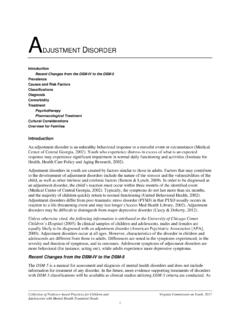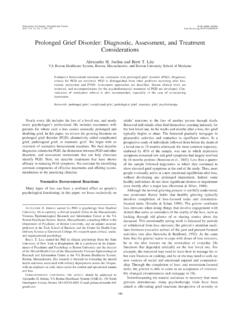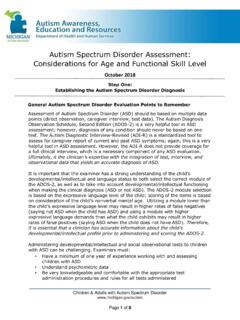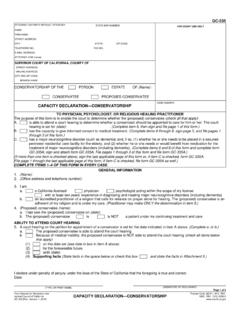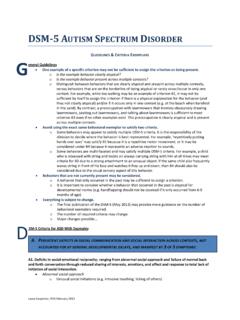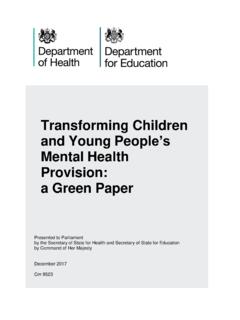Transcription of An Attachment Theoretical Framework for Personality …
1 Canadian Psychology / Psychologie canadienne 2015 Canadian Psychological Association 2015, Vol. 56, No. 2, 197 207 0708-5591/15/$ An Attachment Theoretical Framework for Personality disorders Kenneth N. Levy, Benjamin N. Johnson, Tracy L. Clouthier, J. Wesley Scala, and Christina M. Temes The Pennsylvania State University Personality disorders are highly prevalent, associated with considerable morbidity, and difficult to treat. Intrapersonal and interpersonal difficulties are central to the pathology observed in Personality disorders . Attachment theory provides a broad yet parsimonious explanatory Framework for understanding the development, maintenance, and treatment of Personality pathology.
2 Attachment theory conceptualizes human behaviour in ways consistent with multiple scientific traditions, including evolutionary, devel- opmental, and neuropsychological domains. The relevant literature has focused predominately on borderline Personality disorder, although a few studies have examined Attachment associations with other Personality disorders , such as narcissistic and avoidant Personality disorders . The authors first outline Attachment theory and discuss assessment of Attachment patterns from both developmental and social psychological viewpoints. Next, the authors present empirical support for Attachment theory and its associations with Personality , including studies of developmental, physiological, neurobiological, and genetic correlates of Personality pathology.
3 They then look at psychotherapy research relevant to (a). underlying components of current psychotherapies, (b) the relation between Attachment and both therapy process and treatment outcome, and (c) changes in Attachment styles as a result of Personality disorder treatment. Finally, the authors call for future research to delve deeper into specific relationships between Attachment constructs and Personality pathology, as well as to address Personality disorders more broadly. Keywords: Attachment theory, Personality disorder, psychopathology, psychotherapy In this article, we propose that John Bowlby and Mary Ain- of functioning without the aid of others (Bornstein, 1993).
4 Such sworth's Attachment theory provides a cogent, empirically based, interpersonal challenges have been hypothesised to stem from clinically useful, and theoretically coherent model for understand- underlying maladaptive Attachment schemas ( , Fonagy et al., ing many of the intrapsychic and interpersonal aspects that are 1995; Gunderson, 1996; Levy & Blatt, 1999). Our goal is to central to Personality disorders (PDs). This Theoretical Framework outline and elaborate on Attachment theory as a foundation for the brings both parsimony and breadth to the conceptualisation of the etiology and pathology of PDs and to highlight the implications of etiology, maintenance, and treatment of PDs.
5 Further, Attachment this theory for treatment. We begin with a review of Attachment theory is consistent with research findings from a host of studies theory and its empirical basis, reviewing findings from neurobio- across multiple domains of knowledge, including evolutionary logical and developmental literatures linking Attachment and PDs. biology, ethology/comparative psychology, developmental psy- We then examine the role of Attachment in psychotherapy process chology, experimental social- Personality psychology, and neuro- and outcome. Finally, we summarise the implications of attach- science (Fonagy, Luyten, & Strathearn, 2011; Levy, Beeney, & ment theory for understanding PDs and present directions for Temes, 2011).
6 Future research. Difficulties with Attachment are often at the heart of most PDs (Levy, 2005). Antisocial (AS), narcissistic (N), avoidant (AV), and schizoid (SZ) PDs, for example, are characterised by impoverished Attachment Theory interpersonal relationships. On the other hand, those with border- Early interactions between child and caregiver are at the core of line Personality disorder (BPD) and dependent Personality disorder Attachment theory. The affective bond that develops between care- (DPD) tend to struggle with intense feelings of aloneness and fears giver and infant is the developmental nucleus of identity forma- of abandonment (Gunderson & Lyons-Ruth, 2008).
7 Individuals tion, intrapersonal regulation, and interpersonal attitudes (Bowlby, with BPD tend to have intense and stormy relationships (Levy, 1973, 1977). The Attachment bond, according to Bowlby, is a 2005), whereas those with dependent pathology appear incapable complex, behavioural system that has functioned throughout hu- man evolution to protect the infant from danger by seeking secu- rity from a caregiver guardian, thus enhancing the infant's likeli- hood of survival and eventual reproduction. At the same time, this Kenneth N. Levy, Benjamin N. Johnson, Tracy L. Clouthier, J. Wesley bond promotes comfort during stressful periods, reducing negative Scala, and Christina M.
8 Temes, Department of Psychology, The Pennsyl- vania State University. affect and allowing the infant to develop a healthy, realistic, and Correspondence concerning this article should be addressed to Kenneth coherent sense of self (Fonagy, 1999). N. Levy, Department of Psychology, 362 Bruce V. Moore Building, The Although this adaptive form of Attachment is perhaps ideal, Pennsylvania State University, University Park, PA 16802. E-mail: Bowlby suggested that other modes of Attachment exist. He hy- pothesised that security of Attachment derives from a caregiver's 197. 198 LEVY, JOHNSON, CLOUTHIER, SCALA, AND TEMES.
9 Reliable and sensitive provision of love and comfort, as well as remains unable to connect emotionally with others who could food and warmth. Infants with a caregiver who meets their bio- provide support. Fortunately, later relationships may continue to logical and psychological needs turn to their caregiver when ex- alter these models, correcting for unhealthy views of self and periencing distress, fear, or other needs (safe haven), while other- others, and leading to more adaptive interpersonal interactions wise exploring their surroundings with a sense that the caregiver is (Fraley, 2002). looking out for them (secure base).
10 However, if the infant's needs are not met by a caregiver, then adaptive Attachment is disrupted. Attachment in Adulthood These infants are unable to garner support from their caregiver when distressed or are limited in their ability to explore during Both developmental and social psychological research traditions stress-free times. Thus, differences in styles of behaviour sur- have focused on the evaluation of adult Attachment schemas. rounding the caregiver as safe haven and secure base reveal Developmental psychologists generally assess Attachment patterns underlying disparities in the formation of the infant caregiver through the Adult Attachment Interview (AAI; George, Kaplan, &.)










